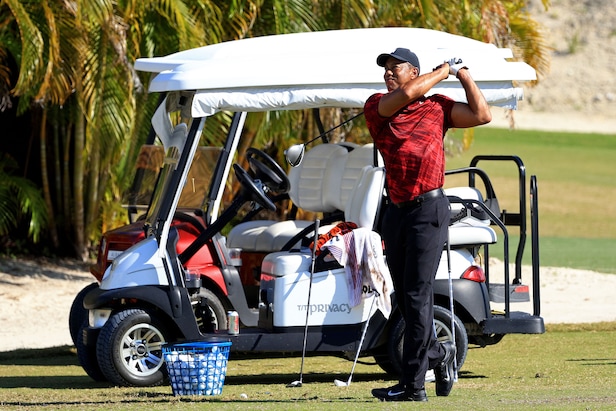Tiger Woods seems to be sending mixed signals. On one hand, he’s imploring people to temper expectations, that he’s a long way off from competing at the PGA Tour level and, if we take him at his word, that he’s not sure he’ll ever get to that point. But then he kept on hitting balls throughout Hero World Challenge week. And, most notably, he’s committed to returning to golf (kind of) in next week’s PNC Championship, less than 10 months after his horrific car accident.
There’s a camp of followers that believes Woods will factor in this year’s Masters. There’s another that’s still skeptical he’ll ever return to top-level competition. Woods’ status as a sporting icon also clouds the picture; because the golf world so desperately wants him back, any positive sign—that initial swing video, or his range sessions, or his PNC plans—can easily be mistaken for concrete evidence that the comeback train’s trundling toward glory.
What, then, is actually going on? How close is Tiger to returning to the PGA Tour? And what should we make of his recent flurry of activity?
“It’s definitely a step in the right direction,” says Dr. Ara Suppiah, founder of the Functional Sports Medicine Institute and a Golf Digest contributor. “But let’s start with the actual injury—or, at least, what we know about the injury. We know his weight bearing bone in his lower right leg, the tibia, was broken in multiple places and that a rod was inserted to bring those pieces together. We know he had multiple fractures to the bones in his foot and ankle, which needed pins or plates.”
On the night of his accident, Woods’ initial injuries were described as “comminuted open fractures to both the tibia and fibula” by Dr. Anish Mahajan, CEO of the Harbor-UCLA Medical Center. Woods also required surgical release of the covering around the muscles in his leg to relieve pressure due to swelling.
Tiger noted during his press conference last week that amputation of the leg was on the table. Suppiah says: “Amputation would only be an option if the wound was not healing properly—say, if it was infected—or if blood flow to the leg was an issue. We also know that he is in pain every day.
“Now, if you take those injuries and try to construct a golf swing, there will be a number of issues. One is that the affected limb, his right, may be shorter than the unaffected limb. That will result in wear-and-tear that is different than what he’s used to and can impact the knee, hip and lower back.”
How much of an issue that might be, Suppiah said, would determine the length discrepancy. He did note, however, that shoe technology has improved drastically and that Woods could easily have a customized shoe made to ensure his pelvis is level and mitigate the impact.
“He’ll need to turn on his right leg on the back swing and then push off it to use the ground force and generate speed in the through swing. How much he’s able to do that will largely depend on how much pain there is. He can clearly make 10 swings, but can he make 200? We still don’t know.”
Suppiah suggested the ankle will play a crucial role in determining how much and how quickly Woods might be able to return to tour-level competition.
“Will the ankle swell up when it exerts force on an uneven surface? When you have surgery, with the injuries he has suffered, invariably there will be a loss in the range of motion in the ankle and foot joint. The ankle is a bit like the wrist; it has to be able to move in multiple directions to withstand and create force. How much of that can he do?”
The PNC Championship’s format won’t provide a full picture of Woods’ prospect, Suppiah says, due to its format. There are just two days of competition. Woods will drive around the course, which is flat to begin with, in a cart. He will not have to hit every tee shot and can pick up when he’s out of a hole or faced with a dicey lie.
“Swinging on a level playing surface is very different from walking on hilly courses, terrain, rough. He’s not close to that yet. Now, this is very, very positive. It’s definitely a huge step in the right direction, but there’s still a long way to go. If he is having pain every day, that’s a huge load. It’s not just pain—it’s suffering. It’s the mental agony of dealing with chronic pain. That is exhausting.”
Woods was recovering from a microdiscectomy procedure to his lower back at the time of the accident. That December 2020 operation was the fifth he’s had on his back but first since a career-saving spinal fusion surgery in April 2017. Suppiah does not foresee the back being an issue at least initially.
“Any back injury, when you take pressure off the back and rest it, will be better. I don’t know what happened to the back when he had that accident. The car rolled over, and forces were strong enough to break his leg and his ankle, which means he would’ve been in a precarious position. But the back is not being spoken about right now. Even if it was, in the nine months when he was recuperating, it should’ve healed fully.
“Tiger is a savant of the golf swing. If he can walk, he can find a way to swing the golf club. If you took any other average person, who’s not as fit or as driven or doesn’t have the team behind him, you’d be looking at a significantly longer recovery time. But he’s a supremely fit athlete with a drive that is unseen in most everybody. That’s why he is able to do this.”
